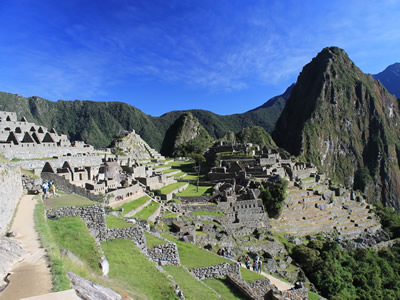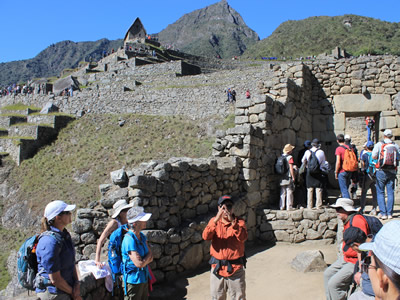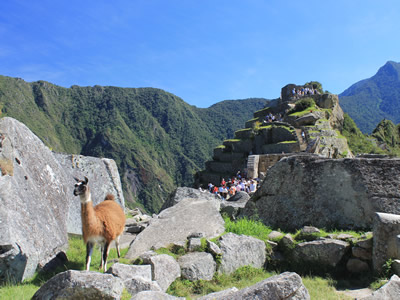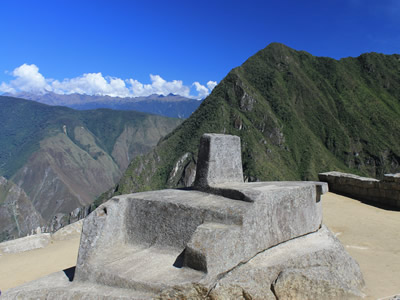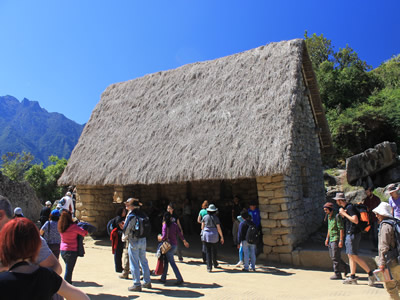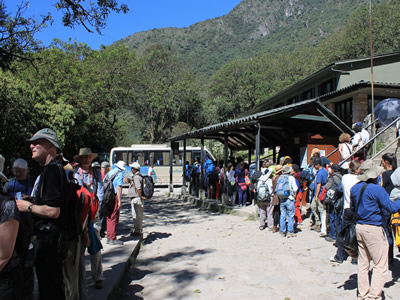Peru - Machu Picchu
Today was our big day. We were going to visit Machu Picchu. It was what had attracted most of us to come on this trip. It is one of the most famous tourist destinations in the world. On Tripadvisor's list of the 25 Greatest Attractions in the World for 2014, Machu Picchu was ranked #1.
So we knew that it was a very popular place. It wasn't always that way. I found visitor statistics for previous years, and from 1980 to 1993 the number of visitors was moderate and fairly stable at about 150,000 to 200,000 each year. During this period the Communist Shining Path insurgency (Sendero Luminoso) was very active and posed a real threat to the democratic government and people of Peru. It is estimated that 31,000 Peruvians were killed by the Shining Path during this time period. Although they were not active in the Cusco region, the insurgency strongly discouraged most foreign tourists. When the leader of the Shining Path, Abimael Guzman, was captured in 1992 the movement quickly collapsed, although it did not completely disappear.
With the return of political stability, foreign tourism and the number of people visiting Machu Picchu sky rocketed. It's popularity increased dramatically with more visitors every year. In 2013 the number reached 1.2 million, so many people that they were posing a threat to the preservation of the monument and straining the nearby infrastructure. Today the government of Peru limits the number of visitors to 2500 per day. This spring a new set of regulations were released to further control access to the monument and reduce the damage caused by visitors.
We knew it was going to be crowded. After our breakfast we walked to where the buses left. There was already a line with about thirty people. This would be a test of how efficient their operation was. A bus pulled up and in a few minutes all the people ahead of us had boarded. The bus pulled out and two minutes later another bus pulled up. Ok - they knew what they were doing. We climbed on the bus and in a few minutes we were on our way as well.
It was a 1200 foot climb from Aguas Calientes, where we had spent the night, to Machu Picchu. A very steep 1200 feet. The dirt road that switchbacks from the town to the monument is only open to buses. But it is still busy, with the buses only about two or three minutes apart all day. At every blind hairpin turn on the road the driver would honk to make sure another bus wasn't coming. In many places the road was only wide enough for one bus and when we met someone coming down we had to back up. It all seemed pretty scary. I just kept reminding myself that our bus driver would probably do this twenty times today. Just like he did it yesterday and just like he would do it tomorrow. Accidents probably did happen but the best that I could do was hide in probability and statistics. This time Fortune smiled on us and we made it safely to the top. Then we made the most important stop for an older group - the bathroom break. There are no restrooms inside the monument. Then we were ready to go. Juan handed out our tickets and we filed through the entrance.
Our friend Reuben, who had led our tours in Cusco, rejoined us to lead our tour of Machu Picchu. As soon as we were inside the monument he took us to a high point on the terraces where we had a great view of the entire site. To the south we could see the Cordillera Vilcabamba where we had spent the last week hiking. If we looked very carefully we could see the Llactapata ruins and our lunch stop from the day before, far away across the valley of the Rio Vilcanata. It was fun to look back at the spots that we had been the day before, when we had been looking towards the ruins where we were now.
Machu Picchu was "discovered" in 1911 by an American explorer, Hiram Bingham. He theorized that it was the last city of the Incas, the mountain refuge that they retreated to in an effort to escape the Spanish conquest. Modern thought is that it was a royal retreat built primarily by the great Inca Pachacutec around 1450, before the arrival of the Spanish, and that it was probably abandoned by the Incas soon after the Spanish arrived.
The ruins of Machu Picchu are impressive. It's location, on the crest of a ridge, high above the valley floor, is amazing. It is hard to imagine the effort that went into building a city in such a difficult location. Even beyond that is the care that went into the construction. The craftsmanship to build the walls, perfectly matching the shapes of the stones so they fit together without mortar, is mind boggling. The construction of Machu Picchu is an incredible accomplishment.
Reuben took us through the entire complex, explaining the history as we went. He did a great job. But as noon approached we were ready for a break. We had covered a lot of ground. The sun was hot. We had been dealing with crowds of people. We were getting hungry. We went outside the monument to the Machu Picchu Sanctuary Lodge for lunch. It was a buffet but we were hungry. It sure tasted good.
After lunch it was decision time. Some people decided to go back to the monument to wander around the ruins on their own. Some people chose to hike to the Sun Gate. It's the place where people hiking on the Inca Trail first see and start their descent into Machu Picchu.
This time we took the easy option. Sandy and I decided to head back down to town after lunch. We had been tough on the trek, always opting for hiking even when we didn't feel well. But today we would go back to Aquas Calientes. We wanted to walk through town. We wanted to spend time in the markets. There was a lot of cool stuff, both for ourselves and for gifts for family and friends. And we wanted to be back in plenty of time for cleaning up and relaxing with drinks before dinner. We had done plenty of hard work to get here.
